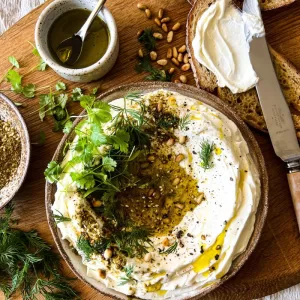
Garlic Labneh Dip with Za`atar, Pine Nuts & Herbs
Enjoy this twist on a traditional labneh dip enhanced with garlic, aromatic Za'atar, buttery pine nuts and fresh herbs. Perfect for spreading, dipping, or pairing with your favourite Middle Eastern dishes!
Equipment
- Fine mesh strainer
- Muslin or clean chux cloth
- Large bowl
Ingredients
LABNEH DIP
- 500g thick Greek-style natural yoghurt
- ½ teaspoon salt
- 1 clove garlic, grated
TO GARNISH
- Extra virgin olive oil, to drizzle
- 2-3 teaspoons za`atar, for spinkling (See Note 2)
- 1 tablespoon pine nuts, toasted
- Fresh herbs, to garnish (I used dill and micro-green coriander)
TO SERVE - PICK ONE OR MORE
- Fresh Lebanese bread
- Pita bread
- Sourdough Crispies (See Note 3 - I used these)
- Crackers
Instructions
- Line a large sieve with muslin or a clean chux-style cloth and place over a large bowl. Place yoghurt into a bowl, add salt, and stir well to combine. Spoon the yoghurt mixture into the lined sieve. Fold over the muslin or chux to loosely cover. Place into the fridge overnight to drain.
- To make the dip, transfer the strained yoghurt to a medium bowl, discarding the whey in the large bowl (or keep for other uses). Add the grated garlic to the yoghurt and stir well. Pop it back into the fridge for 1 hour for the garlic to infuse.
- To serve the labneh, spoon into a shallow bowl or plate. Using the back of a spoon, make a well in the centre.
- Drizzle the labneh with olive oil and sprinkle with za`atar, pine nuts and extra fresh herbs. Season with cracked black pepper. Serve with Lebanese bread, pita and/or crackers along with any additional extras you desire (see Serving Suggestions in post above).
Notes
- COOKS NOTES:
Oven Temps: Oven temperatures are for conventional, if using fan-forced (convection), reduce the temperature by 20˚C.
Measurements: We use Australian tablespoons and cups: 1 teaspoon = 5 ml, 1 tablespoon = 20 ml & 1 cup = 250 ml.
Herbs: All herbs are fresh (unless specified) and cups are lightly packed.
Vegetables: All vegetables are medium size and peeled, unless specified.
Eggs: We use extra-large size and eggs are 55-60 g each, unless specified. - ZA`ATAR
Za'atar is a popular Middle Eastern spice blend made from dried herbs such as thyme, oregano, marjoram, and sometimes sumac, mixed with toasted sesame seeds and salt. This aromatic mixture is often used as a seasoning for breads, meats, vegetables, and dips, providing a tangy, earthy flavour with a hint of nuttiness from the sesame seeds. Za'atar is also mixed with olive oil to create a dip or spread for bread or as a seasoning for various dishes.
Za`atar can be purchased from gourmet grocers, online food and herb stores, Middle Eastern shops or you can make your own at home. Its very simple with some common pantry staples. Recipe coming soon to Feed Me Kate...
Sub with dukkah which can be purchased from local supermarkets in the herb section. - SOURDOUGH CRISPIES
These are one of my favourite snacks to make with leftover or stale sourdough bread. They store for weeks in an airtight container and are great for dips, soups, topping with canned tuna etc and just for nibbling on.
To make, slice sourdough bread as thin as you possibly can. Mine are usually around 3-4mm in thickness. Lay on a baking tray, without overlapping, and bake in a low 130C oven for around 15-20 minutes, flipping halfway through or until they are dried out and crisp. Allow to cool fully then store in an airtight jar or container at room temperature for up to 1 month or more!